How the Schauburg became a Cinerama cinema |
Read more at in70mm.com The 70mm Newsletter |
| Written by: Sebastian Graf. Text source: „Die neue Schauburg ist nicht wiederzuerkennen“, from: Badische Neueste Nachrichten, 25/09/1968 | Date:
30.09.2016. Original page published 17.08.2005 |
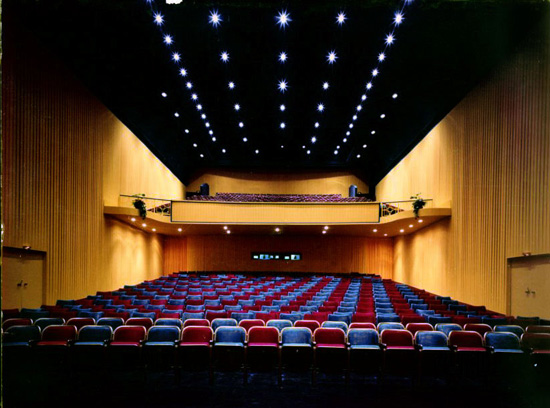 The
1949 post-war reconstruction of the vast auditorium of the Schauburg
established it as an incredible 1000-strong venue; while the current
capacity is 350. Happily the screen size has remained unchanged to date. The
1949 post-war reconstruction of the vast auditorium of the Schauburg
established it as an incredible 1000-strong venue; while the current
capacity is 350. Happily the screen size has remained unchanged to date.The renovation of the time-honoured Karlsruhe cinema and its reopening with Stanley Kubrick’s "2OO1: A Space Odyssey" on 25/09/1968 "The Schauburg of old has given up the ghost," proclaimed the Badische Neuesten Nachrichten on 2 July 1968, with regard to the private-sector restoration of the sole cinema in the Karlsruhe district of Südstadt. Willi Mansbacher, the previous proprietor who had leased the cinema to Cinerama (the German subsidiary of the American Cinerama Group), had spared neither cost nor effort in conveying a new cinematic experience to audiences through that modernisation then. The doors of the Schauburg on Marienstrasse had originally opened in 1929 on the premises of the former Apollo Varieté theatre, which had been screening films since 1906. The cinema had been completely destroyed during World War 2 and had been rebuilt at the same location in 1949. The next renovation was performed in the summer of 1968 when it became hailed as "the sole Cinerama-Lichtspiel movie theatre in Baden-Württemberg" on 25 September 1968 (BNN dated 25/09/1968) at its' reopening. The first movie presented was a screening of Stanley Kubrick’s "2OO1: A Space Odyssey", two weeks ahead of its national German premiere in 1968, a worthy cinematic contribution to this occasion even from today’s perspective. The renovation in 1968 did not take quite as long as the almost 3 years it had taken to produce the film, and was completed, including the golden wallpaper, for approx. DM 300,000. By today’s standards that is an incredibly small sum for such a conversion of Karlsruhe’s first large-capacity cinema. Those responsible undertook a strategy of using technically innovative and aesthetically pleasing design techniques in order to benefit the public. |
More in 70mm reading: How Georg Fricker became the owner and operator of the last of Karlsruhe’s “picture palaces” Wie die Schauburg Cinerama-Kino wurde 70MM at the Schauburg Schauburg Cinerama, Karlsruhe, Germany. Home of The Todd-AO Festival Stanley Kubrick's "2OO1: A Space Odyssey" in Super Panavision 70 2OO1: a space odyssey Campaign 2OO1: A Space Odyssey Essential Presentation Procedure |
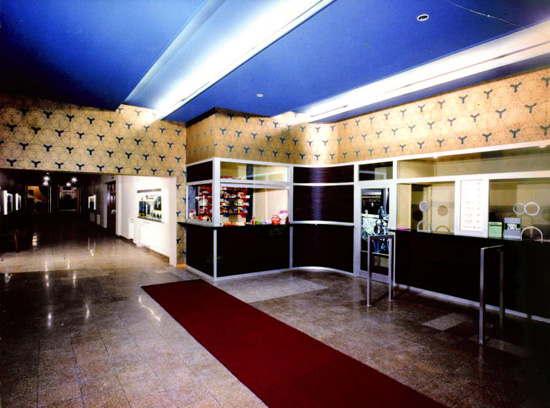 Architectural and structural factors in the cinema comprised a substantial component of
these considerations. The 17 x 7m and 120 degree curved Cinerama screen
that replaced the paltry, old 6.90 x 4.50m screen would be certain to place the
individual cinephile, amongst a 670 strong audience in a full house,
into
the centre of the action in a Cinerama cinema. The 1949 post-war
reconstruction of the vast auditorium of the Schauburg established it as an
incredible 1000-strong venue; while the current capacity is 350. Happily
the
screen size has remained unchanged to date. Architectural and structural factors in the cinema comprised a substantial component of
these considerations. The 17 x 7m and 120 degree curved Cinerama screen
that replaced the paltry, old 6.90 x 4.50m screen would be certain to place the
individual cinephile, amongst a 670 strong audience in a full house,
into
the centre of the action in a Cinerama cinema. The 1949 post-war
reconstruction of the vast auditorium of the Schauburg established it as an
incredible 1000-strong venue; while the current capacity is 350. Happily
the
screen size has remained unchanged to date. The movie theatre also created interest visually in 1968; the oval of the stairways up to the balcony in what we today call "Cinema" can seat 150 visitors and exudes a sense of familiarity to passionate Schauburg moviegoers. The cinema’s sweeping, opposed stairways from 1949 have now been declared as listed. Access to these stairs is gained through a 25m long foyer which connects the entrance lobby from Marienstrasse with the refreshments area providing snacks and beverages, and a bit of a waiting area / lounge. The projection room, accessible from the foyer, is now on the lower level so that all projectors aim straight on to the curved screen through one of five projection ports for 70mm, 35mm and 16mm formats. A low grille is installed on both the outer rows of the balcony so that the audience are afforded an unimpeded view of the screen below. |
|
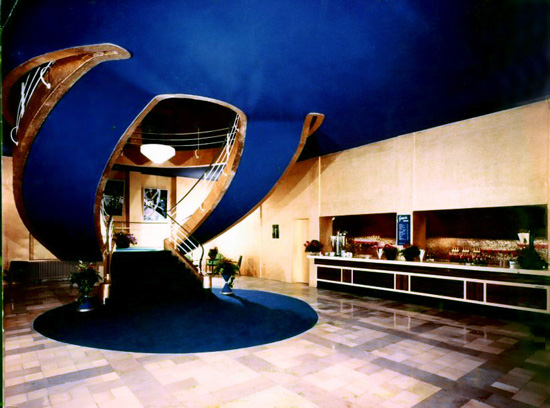 The
cinema’s sweeping, opposed stairways from 1949 have now been declared as
listed. The
cinema’s sweeping, opposed stairways from 1949 have now been declared as
listed."2OO1: A Space Odyssey", the feature-film listed for the reopening even then was no mere "space encounter caper" (BNN dated 25/09/1968), but set a benchmark far beyond the hitherto casually regarded science-fiction genre. Kubrick wrote movie history with "2OO1: A Space Odyssey" and thereby elevated the genre. The film is still worth watching today due to its technical and philosophical complexity as it has lost neither its shattering effect nor its entertainment value. Kubrick had therefore delivered a breakthrough into a new cinematic era like no other. Bearing this in mind, the choice of Kubrick’s masterpiece for the re-opening of the "new" Schauburg symbolises a cutting-edge approach to the cinematic experience where each member of the audience feels at the centre of the action in the film. The architectural ambience of the renovated Schauburg along with the innovation in projection techniques is in harmony with the progressive nature of the film and defines the summit of cinematic atmosphere over decades; in keeping with the status Kubrick’s sci-fi piece has achieved within the genre of phantasmagorical films. A brighter production design bids a comprehensive farewell to the tired old rooms of early sci-fi; along the lines of Kubrick’s 140 minute long opus, a space age design stages a contrast with the dark expanses of the universe. |
|
 The
17 x 7m and 120 degree curved Cinerama screen that replaced the paltry, old
6.90 x 4.50m screen. The
17 x 7m and 120 degree curved Cinerama screen that replaced the paltry, old
6.90 x 4.50m screen. In parallel to the Schauburg in 1968, "2OO1: A Space Odyssey" was also unprecedented with its overwhelming mise-en-scène and technical perfection. The projection of moving images at the Schauburg Cinerama was arranged in as technically sophisticated a fashion as with Stanley Kubrick, and was equally progressive and visionary as him as he wove his image and soundscapes meticulously together. The movie, based on a short story written by Arthur C. Clarke in 1948, was filmed in Super Panavision 70 with production costs of 10,5 million US dollars. It turned out to be the most commercially successful film of 1968 with worldwide box-office takings of over 190 million US dollars and thereby topped the ratings. A Cinerama screen such as the Schauburg’s seems to be made for the vast imagery generated by this MGM classic because the film comes to life most notably in the scenes of outer-space in its central portion. It is far from a chamber play, and thus deserves this most befitting venue. The Schauburg is as aesthetic and stylistic as "2OO1: A Space Odyssey" and has duly not lost any of its fascination to date. Ownership under the Cinerama brand lasted only a few years. Willi Mansbacher cancelled his contract with the Cinerama company after three years, and in 1972 he sold the Schauburg to the young and enthusiastic Georg Fricker, who changed the program of the Schauburg to an arthouse cinema. Until today the Schauburg is one of Germany’s most prolific arthouse cinemas and has won programming awards almost every year. Despite the film theatre being listed and somewhat isolated from Karlsruhe’s "golden mile" in the inner city, it attracts cinephiles and cineastes alike from the world over. Particularly so now that the 12th annual 70mm TODD-AO festival will spread some international glitter that attracts not just the cinephiles. And last but not least; that the Schauburg is one of the few movie theatres in Germany that, through its projection technique, has cultivated and preserved the aesthetic for film production in the 70mm TODD-AO film format to the present day, more than serves justice on the cinematic claims of Stanley Kubrick and other Hollywood masters. • Go to How Georg Fricker became the owner and operator of the last of Karlsruhe’s “picture palaces”. |
|
Examples of Schauburg's 7OMM Program |
|
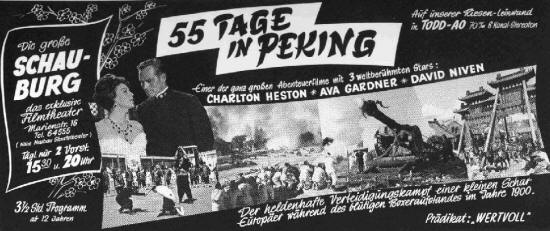 |
|
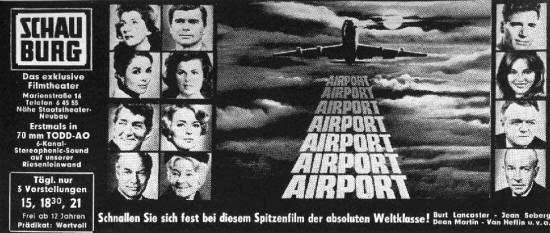 |
|
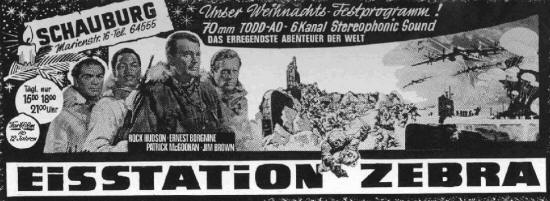 |
|
| Go: back - top - back issues - news index Updated 21-01-24 |
